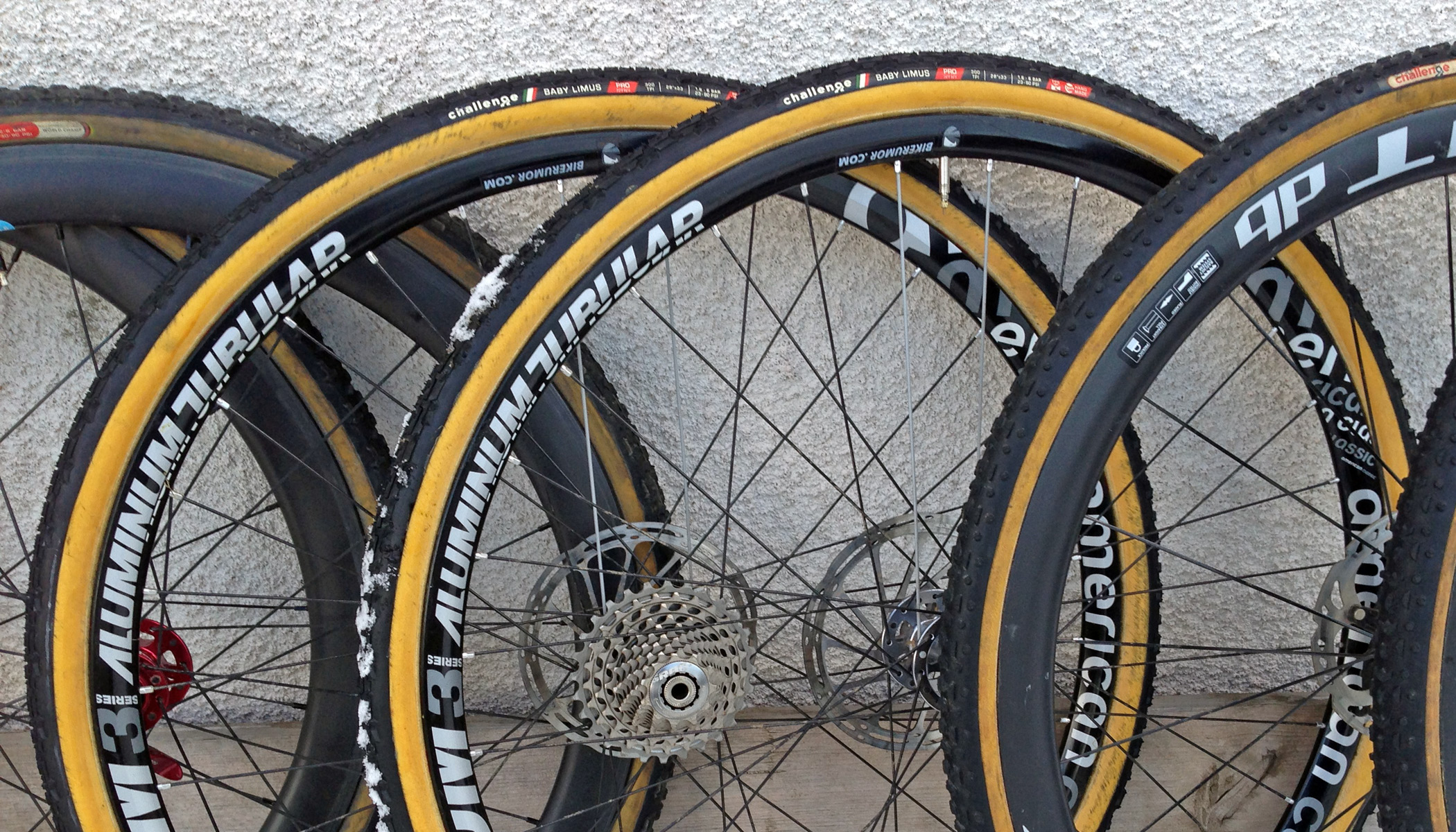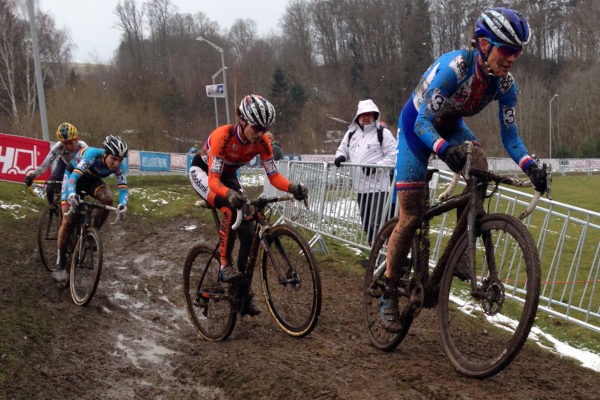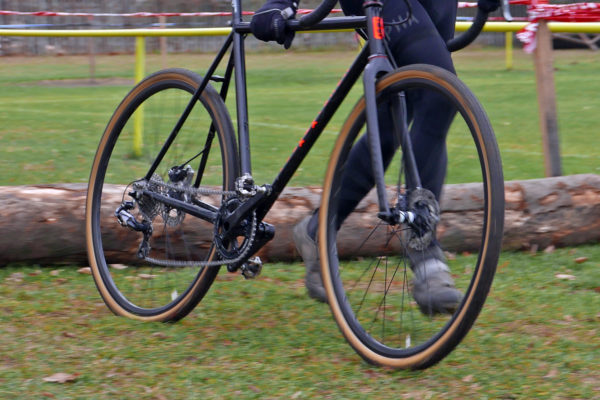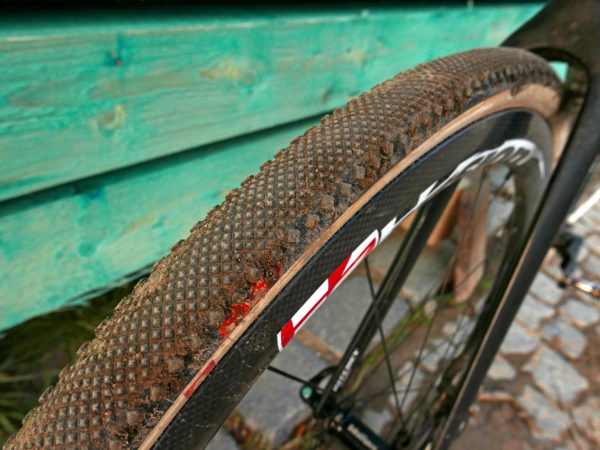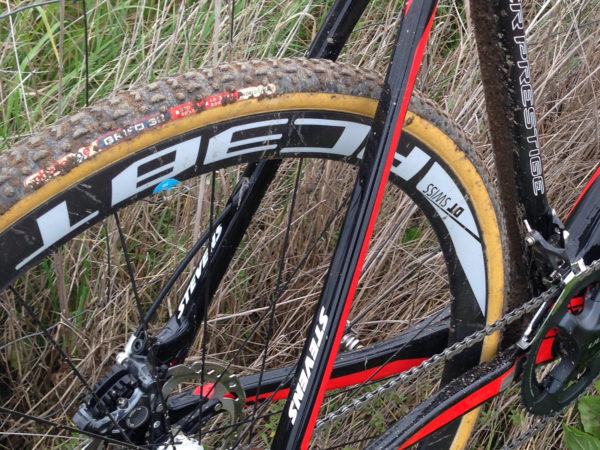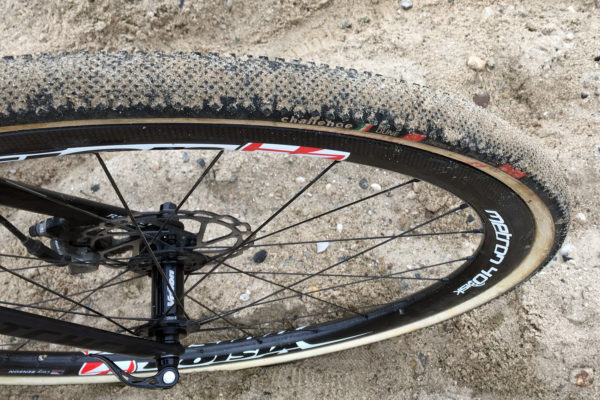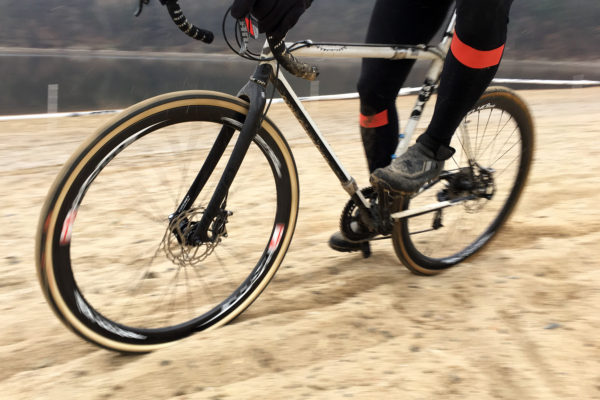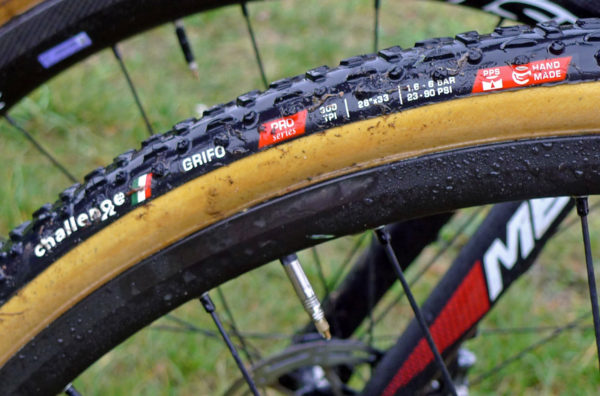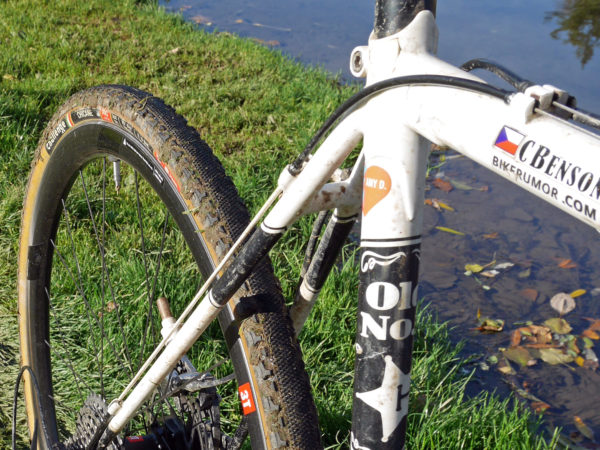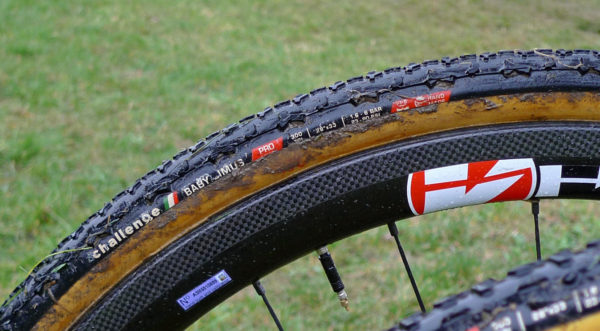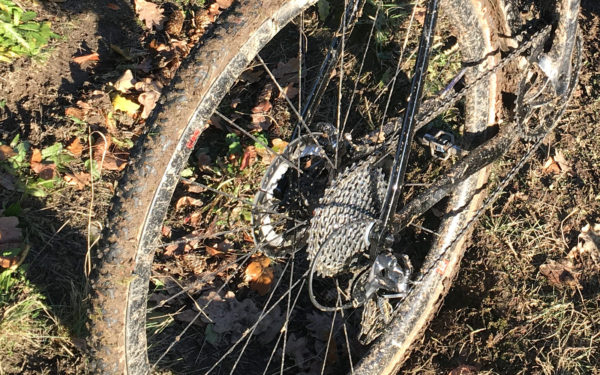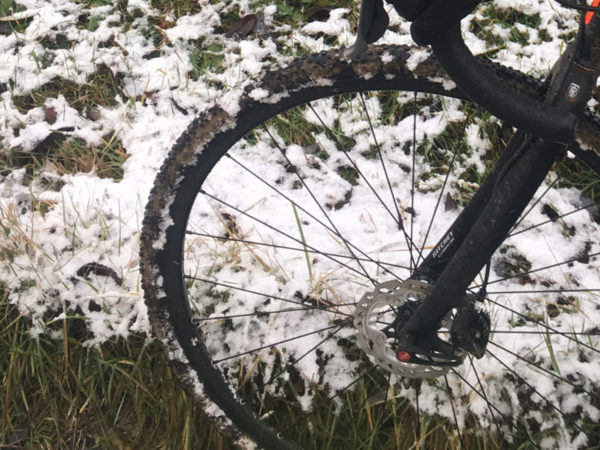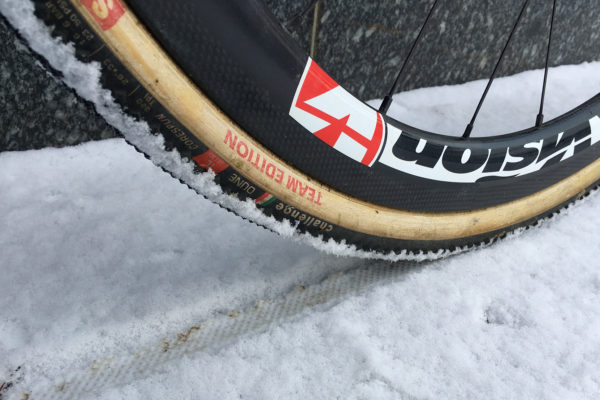Yesterday we featured the tire pressure ‘rule of thumb’ of 9-time British Cyclocross Champion Helen Wyman as we lead up to a weekend of Cross Nationals around the globe. As the pros get ready to face off for their most important end-of-season races we’re sharing some key tips we’ve gleaned from the racers, mechanics, and tire makers to get the most traction in a discipline where wet, muddy, sloppy conditions are actually what make it so much fun. Now that you have committed to testing tubular pressures down in the 20s, lets see that you pick the best tread for the course and conditions…
The following is excerpted from our 2016-17 Bikerumor Cyclocross Buyer’s Guide. You can go download that directly here for free to get the low down on what is available now, as well as some other training tips and cyclocross backstory. Tire pressure is one thing, but proper tire selection is a whole ‘nother animal. In the spirit of truly geeking out, we spoke with Kona & Challenge-sponsored Helen Wyman herself, as well as her own in-house tech specialist – husband Stefan Wyman. The result? The Wyman Method for cyclocross tire selection out of her quiver of Challenge tires, a few of which she was instrumental in developing, all based on course and weather conditions…
The Wyman Method for tire selection
Condition: PREDOMINANTLY HARDPACK
First Option Dry: Provided it was dry (Potentially dusty), I would start my pre-ride on the Dune. These tires are very fast and have more grip in the corner that you’d imagine. If you find you slide beyond what you feel comfortable with in the corners, try to lover the pressure, in very small increments.
First Option Wet: Hard Packed Ground when wet will usually only give you a problem in the corners and transition areas. I would first try the Chicane as these give you all of the confidence in the corners. You might even be able to run these at a slightly higher pressure, as you’ll naturally have the grip in the corner.
Other Options and Scenarios: If the course has muddy sections due to the wet (Maybe you are in a late race and the course is already cut up), then go with the Grifo. This is a great option providing you with the best of both worlds above. You can be confident with a Grifo and they give you amazing variability when you alter the pressure.
Remember: You don’t need to run the same tire tread front a back. Also don’t assume the same pressure front and back is the right option for you. Always ride what’s best for you. Don’t be influenced by those around you. Riding with confidence in your equipment makes you fast. Approaching a corner slowly because you’ve risked a more aggressive tire choice could slow your lap time down.
Condition: LOOSE OVER HARDPACK
First Option: Grifo – When the ground is loose, you need to feel at one with your bike. You need to put your focus in pre-ride to find the best lines. The Grifo gives you the ability to move around on your bike and give you the right balance between grip and speed on the straights.
Second Option: If the course is loose, but you fancy riding in a “foot out flat out” way, try the chicane. Maybe you’ll slide a few more inches but you can be sure the side wall grip is going to kick in and you’ll be fast on the exit as soon as you hit the straight.
Other Options and Scenarios: Loose ground can be cover to many things. If the loose sections are on up hills, you need to consider a Baby Limus rear so you can really get the power down and keep traction.
Remember: Always consider the type of loose ground you on. You might want to run slightly higher pressure to avoid a flat if there are largish stones on the course. Ride with finesse and you’ll be fine. My tip would be have a slightly higher pressure on your pit bike to avoid a 2nd issue.
Condition: DRY COURSE WITH SHORT SAND SECTIONS
First Option: Whatever you would have used for the course should the sand not be there. Don’t change your race for one short section of sand. Consider the remainder of the course first and put your energy into being first into the sand pit.
Second Option: If there are multiple sand sections, try the Dune on a low pressure. This is the natural choice for loose sand, but if it’s going to neutralize the way you ride the remainder of the course then it’s potentially not worth it.
Remember: You can ride sand on any of the Challenge tire options. Dry sand is loose, and often best ridden on a round tread with low side knobs avoid grabbing the sand, like the Grifo or Dune. Ride the ruts, and look forward to the exit of the sand pit.
Condition: SAND
First Option: Dune is the natural tire choice for these conditions. Think of the Koksijde world cup course as a pure sand course and you are looking to float over the sand and keep as little sand flicking all over your drive train from the tire treads as possible. Run them low.
Second Option: The Grifo might allow you to run a slightly more balanced race. If there is a little moisture in the ground, a fraction of the skill of sand riding has been taken away, and the sand will lean towards speed than balance. Having the ability to corner fast in the wetter corners could mean faster entrance to sand sections.
Other Options and Scenarios: If you have sand on one side of course and not on the other, you could consider 2 set ups if there are going to be a large number of pit changes. If you can change fast you won’t loose time and could have the best options for both sides of the course.
Remember: When riding sand, steer with your eyes by being focused on the exits to the sand zones. You can ride sand on any of the tire options available from Challenge. Start aggressive and move up the grip options as you feel necessary.
Condition: DRY GRASS
First Option: Grifo – I tend to run slightly lower pressure in the front for my first lap of pre-ride and see how that rolls. Dry grass and fast transitions make for quick races, but often moisture comes out of the grass as it’s ridden over so the conditions can change slightly. Often you see this with slippery corners.
Second Option: The choice of many for grass is the Chicane. Fast in a straight line and great on camber, the chicane can give a great second option for grass races. Even with higher pressure, these are option well worth trying.
Other Options and Scenarios: The Baby Limus might give you that little more security in the corner, particularly where the grass is a little longer and you get some great hook up in the large side wall tread. Or the Dune will be ideal for those confident in a course, perhaps varying their line accordingly as a race progresses.
Remember: If you are pushing things with your first option, put a more grippy option onto your 2nd bike. A fast dry course should mean no changes. A change in these conditions means potential disaster recovery, so plan for it in advance.
Condition: WET GRASS
First Option: Wet grass means you need to be very aware of changes of condition during a race and try to predict what you might need. Remember things can change a lot from your last warm up lap to the race. I’d start with a Chicane. But be totally prepared to switch mid race.
Second Option: I’d have a Grifo on my 2nd bike. I’d run them nice and low to try to cover a lot of options.
Other Options and Scenarios: If you think the course could really cut up, then consider the Baby Limus. You’ll have lots of grip and it will clear very quickly on any asphalt sections.
Remember: Find the limits of the tires. Don’t change for more grip before you have experimented with your pressures.
Condition: WET DIRT
First Option: The Limus will give you a consistent performance right the way around the course. They are faster than you think and mean you might be able to get away with no pit changes.
Second Option: Baby Limus is one step down from the Limus in terms of grip, but for a more aggressive option this could be the one. If you’re lacking grip, lower the pressure.
Other Options and Scenarios: The Grifo is a very happy tire in the dirt, wet or dry. Try it if you don’t quite feel you are getting what you need out of the Limus or Baby Limus.
Remember: Try to read the conditions. If you think it’s going to dry up quickly, plan in advance. Also remember the Baby Limus has the full grip of a Limus in the corners.
Condition: STICKY MUD
First Option: Limus is your best friend in these conditions. All you need to be focused on is finding the right pressure for you, if you can be confident you can ride where others can’t.
Second Option: If you don’t have a Limus in your armory, then consider the Baby Limus nice and low. Get that tread flat across the mud and you will be amazed at the grip.
Other Options and Scenarios: You might be able to get away with a Grifo on the front and Limus on the rear. If the course has multiple long straights, you might be fine with this as it allows you to get the power down and maybe keep the speed up on the asphalt.
Remember: Ride the ruts. They are faster and you can see what’s in them rather than hit hidden obstacles.
Condition: SNOWY MUD
First Option: Dune will come into its own in these conditions showing its versatility. Snow means cold so the grip will be needed in the corners. You might have hidden frozen ruts so plan for slightly higher pressures when first checking out a course.
Second Option: Chicane could be your best option especially if the day is warm enough for the course to defrost mid race. It also have a little more bite in the corners if the snow is loose.
Other Options and Scenarios: You might find a Limus or Baby Limus on the rear and a Chicane on the front could be the fastest option.
Remember: Frozen courses have a lot of hidden problems. It’s worth an extra warm up lap to try to get the course very dialed in.
Condition: SNOW & ICE
First Option: Dune would be the first option for me in pre-ride. I want as much rubber on the floor when I hit ice. Snow itself can give lots of grip in a corner so give the dune a try before scaling up your grip.
Second Option: Chicane might give you a little more grip in the corner helping you flow in the technical sections. These are really good when the course has more protected areas like in woods where less snow has reached the ground.
Other Options and Scenarios: Grifo are good in the ice. A round treads gives smooth transition free corning and therefore a smooth confident feeling.
Remember: Riding in ice is a confidence thing. The more you can ride a course like you would in the dry, the better you are going to be. Try to adjust your tread choice not your riding style.
Condition: ICE
First Option: With all icy conditions I try to ride the Dune. They grip by giving me a lot of surface area on the floor, plus they keep me quick in the straights.
Second Option: Grifo is a good option on the Ice. Running low pressures they give exceptional grip and seem to be very at home in the ice.
Other Options and Scenarios: If you suspect the course will warm up and might get more slick in the corners, start with the Chicane and certainly consider this on the front.
Remember: As with other conditions, set your 2nd bike up to try to predict for course changes and certainly give yourself a more secure option for a last minute change before you can get your pit crew to change your option for you.
Our thanks again to Helen, follow her over at HelenWyman.com & to ChallengeTech.it
